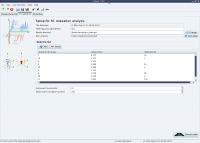Difference between revisions of "User:Troels Emtekær Linnet"
| Line 135: | Line 135: | ||
rm relax-{{current version relax}}.GNU-Linux.x86_64.tar.bz2 | rm relax-{{current version relax}}.GNU-Linux.x86_64.tar.bz2 | ||
ln -s $HOME/relax-{{current version relax}}/relax $HOME/bin | ln -s $HOME/relax-{{current version relax}}/relax $HOME/bin | ||
| + | |||
| + | # Add $HOME/bin to PATH | ||
| + | echo '' >> $HOME/.bashrc | ||
| + | echo 'export PATH=$PATH:$HOME/bin' >> $HOME/.bashrc | ||
| + | source $HOME/.bashrc | ||
|lang="bash" | |lang="bash" | ||
}} | }} | ||
Revision as of 13:15, 28 November 2015
Troels Emtekær Linnet PhD student Copenhagen University SBiNLab
Contents
Tests
<include src="https://raw.github.com/Pymol-Scripts/Pymol-script-repo/master/cyspka.py" />
Test2
<include src="http://www.ietf.org/rfc/rfc1945" />
Test DPL imagecontainer=Screenshots
[[%PAGE%|thumb|185px|A random relax screenshot. See Screenshots.]]
SeriesTab
ls -v -d -1 */*.ft2 > allplanes.list
cd analysis_FT/int_corr_ft_method_all_awk/coMDD seriesTab -in peaks.dat seriesTab -in ../../peaks.dat -out allplanes_coMDD_ser.ser -list allplanes_coMDD.list
Test randomimagebycategor
Test
from math import pi
from lib import nmr
from lib.physical_constants import return_gyromagnetic_ratio
id = 'test'
H_frq = 900.0e6
B0_tesla = H_frq / return_gyromagnetic_ratio(nucleus='1H') * 2.0 * pi
print "B0 in Tesla:", B0_tesla
isotope = '15N'
yOBS_N15_rad_s = return_gyromagnetic_ratio(nucleus=isotope) * B0_tesla
yOBS_N15_ppm = nmr.frequency_to_ppm_from_rad(frq=yOBS_N15_rad_s, B0=H_frq, isotope=isotope)
print yOBS_N15_ppm
# Convert hz
offset_hz = 2100.
offset_ppm = nmr.frequency_to_ppm(frq=offset_hz, B0=H_frq, isotope=isotope)
print offset_ppm
#yOBS_rad_s = return_gyromagnetic_ratio(nucleus=isotope) * B0_tesla
#print yOBS_rad_s
#yOBS_ppm = nmr.frequency_to_ppm_from_rad(frq=yOBS_rad_s, B0=H_frq, isotope=isotope)
#print yOBS_ppm
# Center carriage In ppm
yCAR_ppm = 118.078
Google Cloud Computing
This follows the same idea as from Run relax at cloud.sagemath.com
pricing
For this example of Google Cloud Computing, we wan't to have access to as many computer cores as possible
- The pricing explained here: https://cloud.google.com/pricing/
- A pricing calculator is here: https://cloud.google.com/products/calculator/
For calculation of:
- 1 server
- using Free: Debian, CentOS, ...
- with a regular VM Class
- Instance type of (HIGH CPU) n1-highcpu-32 (vCPUs: 32, RAM: 28.80 GB)
- 0 SSD
- Datacenter location Europe
- Average days per month each server is running: 1 days, per month.
The monthly price was of November 2015, $32.26.
At November 2015, google give free trial of 300$. https://cloud.google.com/free-trial/
Note, there are some limitations: https://cloud.google.com/free-trial/#/faq
Start free trial
Please first see this video:
- https://cloud.google.com/compute/docs/linux-quickstart or https://www.youtube.com/watch?v=BnEhYaUY4sA
Go to: https://cloud.google.com/free-trial/ and click Start your free trial.
You need to sign up with a credit card. To prevent mis-abuse from robots and hackers.
Then go to: https://console.developers.google.com
- You should already have a project called My First Project.
- Create a new project in top right corner of the browser under the dropdown of My First Project.
- Call the new project relax with App Engine location at europe-west
Create a Virtual Machine instance
- Click then at Try Compute Engine or go to https://console.developers.google.com/compute
- Click Create instance
- Name: relax
- Zone: Don't change this. As of Nov 2015, it seems that if you change this, you cannot select more than 2 vCPU's
- Machine type: From the very bottom, create 8 vCPUs. 32 cores need an upgrade to you account, and the free trial only allows for 8 vCPU's.
- Boot disk: 10 GB of Ubuntu 14.04 LTS
- Zone: Now change this to: europe-west1-c
- Let the rest be default and click Create.
Access Virtual Machine instance
- Go to https://console.developers.google.com/compute
- In the line of relax, click SSH
- This should open a browser terminal window
Get relax and unpack
v=5.1.0
# Get relax
curl http://download.gna.org/relax/relax-$v.GNU-Linux.x86_64.tar.bz2 -o relax-$v.GNU-Linux.x86_64.tar.bz2
# Make home bin
mkdir -p $HOME/bin
tar xvjf relax-5.1.0.GNU-Linux.x86_64.tar.bz2
rm relax-5.1.0.GNU-Linux.x86_64.tar.bz2
ln -s $HOME/relax-5.1.0/relax $HOME/bin
# Add $HOME/bin to PATH
echo '' >> $HOME/.bashrc
echo 'export PATH=$PATH:$HOME/bin' >> $HOME/.bashrc
source $HOME/.bashrc
